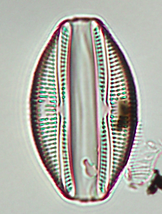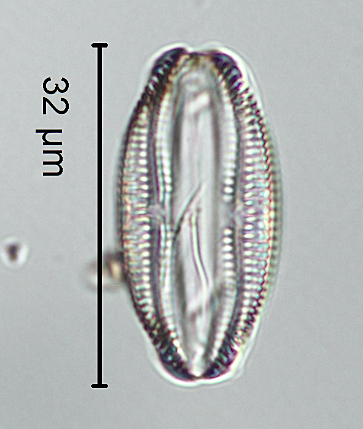Amphora
Amphora is an asymmetrical biraphid diatom which is commonly seen both as a single valve frustule or as a pair. When single, the frustules are shaped like a crescent or an orange slice. When paired, the two frustules commonly look like 2/3 of a peeled orange, as if looking into the missing portion. Amphora is naturally paired, and single frustules are simply those that have broken off from each other- a normal part of their reproduction. Each frustule has two sides to it: the flatter inner-facing side, called the ventral side, and the more-arched outer side, called the dorsal side. The raphe separates the two sides.
Amphora often have a fascia, a "blank" portion located just to the dorsal side of the raphe. They are epiphytic diatoms, growing on the sides of other plant and algae stems.

Dorsal side
Ventral side
Paired frustules

Single frustule
A. copulata
-
Cells are 12-62 µm in length, 4-10 µm in width.
-
Rows of striae are 14-17 per 10 µm.
-
Ventral margin is curved slightly in the same direction as the dorsal margin.
-
Raphe are arched, and their central tips deflect to the dorsal side.
-
Ventral striae start radiate at the center and become convergent towards the tips.
-
Fascia are present, with a small line of areolae between it and the raphe.
For more information, visit diatoms.org here.







A. ovalis
-
Cells are 32-95 µm in length, 8-17 µm in width.
-
Rows of striae are 10-12 per 10 µm.
-
Frustules are generally large, and the ventral margin is arched in the same direction as the dorsal margin.
-
Raphe are slightly arched, and deflect at the center towards the dorsal end.
-
Ventral striae are radiate at the center and become convergent towards the tips. Dorsal striae are radiate.
-
A. ovalis is easily identified by its lack of a central fascia.
For more information, visit diatoms.org here.





A. pediculus
-
Cells are 6-16 µm in length, 2.5-4 µm in width.
-
Rows of striae are 10-12 per 10 µm.
-
Frustules are small, and ventral margin is flat.
-
Raphe are nearly straight, and their central tips deflect to the dorsal side.
-
Ventral striae start radiate at the center and become convergent towards the tips. Dorsal striae are perpendicular to the raphe, becoming slightly radiate at the ends.
-
Fascia is present, with no areolae between it and the raphe.
For more information, visit diatoms.org here.




Unidentified Amphora sp.
-
Single row of areolae on ventral margin; dorsal striae are perpendicular to the apical axis.
-
Approximately 16 striae per 10 µm.
-
Raphe are straight and do not deflect.
-
Ghost striae present in the fascia.
-
Wide central area between frustules.
